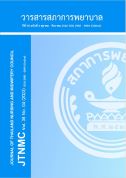Factors Related to Caregiver Burden of Children with Chronic Respiratory Failure with Tracheostomy at Home
DOI:
https://doi.org/10.60099/jtnmc.v38i04.264593Keywords:
caregiver burde, factors, children, tracheostomy, chronic respiratory failureAbstract
Introduction Chronic respiratory failure in children is a significant health problem leading to tracheostomy at home following hospital discharge. Providing long-term care for children at home becomes challenging when they require complex medical treatments, placing a burden on caregivers.
Objectives 1) To describe caregiver burden of children with chronic respiratory failure with tracheostomy at home, and 2) To examine the relationships between caregiving self-efficacy, social support, coping, and caregiver burden of children with chronic respiratory failure with tracheostomy at home.
Design A descriptive correlational design employing Chou’s caregiver burden as the conceptual framework
Methodology Through purposive sampling with inclusion criteria, the sample included 85 caregivers of children aged three months to 15 years old with tracheostomy at home, who were receiving care at a super tertiary hospital in Bangkok metropolitan area and a tertiary hospital in a northern province of Thailand from May 2022 to January 2023. The instruments used for data collection comprised the following: the personal information of caregiver and children questionnaire, the caregiver burden questionnaire, the caregiving self-efficacy questionnaire, the social support questionnaire, and the coping questionnaire. These instruments revealed content validity indices of .86, .97, .92 and .97, respectively and internal consistency reliability, with Cronbach’s alpha coefficients of .90, .95, .95 and .92, respectively. Data were analyzed using descriptive statistics and Pearson’s product-moment correlation.
Results The overall caregiver burden score averaged at a moderate level (M = 2.57, SD = 0.10). Furthermore, caregivers perceived a moderate level of burden across all subscales, including physical, emotional, social, and financial burdens (M = 2.51, 2.42, 3.00 and 3.00, with SD = 0.98, 1.01, 1.15 and 1.15, respectively). Social support was at a high level (M =2.83, SD = 0.07) and revealed a significant negative correlation with caregiver burden (r = -.292, p = .007). Caregiving self-efficacy was high, while coping was at a moderate level; however, there was no significant correlation between these factors and caregiver burden (r = -.182, p = .097, and r = -.139, p = .203, respectively).
Recommendation The results from this study highlighted the burden experienced by caregivers of children with chronic respiratory failure requiring tracheostomy care at home, as well as the factor related to this burden. It is necessary for healthcare providers to provide targeted training programs aimed at enhancing caregivers’ knowledge and skills in home-based child care. Additionally, offering informational and emotional support, along with providing necessary medical equipment, should be considered to alleviate caregiver burden.
Downloads
References
Valko L, Baglyas S, Gal J, Lorx A. National survey: current prevalence and characteristics of home mechanical ventilation in Hungary. BMC Pulm Med 2018; 18(1): 190. doi: 10.1186/s12890-018-0754-x.
Kim HI, Cho JH, Park SY, Lee YS, Chang Y, Choi WI, et al. Home mechanical ventilation use in South Korea based on national health insurance service data. Respir Care 2019; 64(5):528-35. doi: 10.4187/ respcare.06310. Epub 2018 Dec 24.
Home Respiratory Care Unit, King Chulalongkorn Memorial Hospital. Statistics of children with tracheostomy at home 2017-2021, The Department of Pediatrics Faculty of Medicine at Chulalongkorn University. Bangkok: King Chulalongkorn Memorial Hospital; 2021. (in Thai)
Somboon P, Sritippayawan S. Training caregiver skills in providing respiratory care and maintaining related equipment at home. In: Sritippayawan S, editor. Home respiratory care in children. Bangkok: Beyond Enterprise; 2019. p. 147-76. (in Thai)
King AC. Long-term home mechanical ventilation in the United States. Respir Care 2012; 57(6):921-32. doi: 10.4187/respcare.01741.
Lindahl B, Lindblad BM. Being the parent of a ventilator-assisted child: Perceptions of the familyhealth care provider relationship when care is offered in the family home. J Fam Nurs 2013; 19(4):489-508. doi: 10.1177/1074840713506786
Sterni LM, Collaco JM, Baker CD, Carroll JL, Sharma GD, Brozek JL, et al. An Official American Thoracic Society Clinical Practice Guideline: Pediatric Chronic Home Invasive Ventilation. Am J Respir Crit Care Med 2016; 193(8):e16-35. doi: 10.1164/rccm. 201602-0276ST. PMID: 27082538; PMCID: PMC5439679.
Chou KR. Caregiver burden: a concept analysis. J Pediatr Nurs 2000;15(6):398-407. doi:10. 1053/jpdn.2000.16709.
Saopeng Y, Jintrawet U, Chotibang J. Factors related to caregiver burden of children with congenital heart disease after open heart surgery. Nursing Journal CMU 2019; 46(4):13-24. [cited 2021 Jun 27]. Available from: https://he02.tci-thaijo.org/index.php/cmunursing/article/view/229931 (in Thai)
Loomae Y, Wiranphanich W, Wattanasit P. Relationships between burden of care, social support, and quality of life among mothers of children with congenital heart disease. Journal of Nursing and Health Science 2016; 17(2):27- 42. [cited 2021 Jun 27]. Available from: https://he01.tci-thaijo.org/index.php/bcnpy/article/view/70351 (in Thai)
Pattaramai K, Mesukko J, Lamchang S. The relationship between social support and burden among caregivers of children with Thalassemia. Nursing Journal 2021; 48(2):181-92. [cited 2023 Jan 7]. Available from: https://he02.tci-thaijo.org/index.php/cmunursing/article/view/251799 (in Thai)
Preechapongmit K, Lamchang S, Jintrawet U. Factor related to caregiving burden Among caregivers of children with asthma. Nursing Journal 2012; 39(4):13-22. [cited 2021 Jun 7]. Available from: https://he02.tci-thaijo.org/index.php/cmunursing/article/view/7361 (in Thai)
Rattanakamonkarn C, Niyomkar S, Jintrawet U.Self-efficacy, social support, and caregiving burden among caregivers of children with cancer receivingchemotherapy. Nursing Journal 2018; 48(2):232-45.[cited 2021 Jul 12]. Available from: https://he02-old.tci-thaijo.org/index.php/cmunursing/article/view/251811 (in Thai)
Duangdech V. Predicting factors of caregiver burden for children with cerebral palsy Unpublished Master’s thesis. Bangkok, Thailand: Mahidol University; 2007. (in Thai)
Huang MF, Huang WH, Su YC, Hou SY, Chen HM,Yeh YC, et al. Coping strategy and caregiver burdenamong caregivers of patients with dementia. Am JAlzheimers Dis Other Demen 2015; 30(7):694-8.doi:10.1177/1533317513494446.
Chompikul R, Jirapaet V. Experiences the difficultyof caregivers in caring for infant with chronic lungdisease at home. Journal of the Thai Army Nurses2019; 20(1):138-46. [cited 2023 Apr 3]. Availablefrom: https://he01.tci-thaijo.org/index.php/JRTAN/article/view/184951 (in Thai)
Thongsamrit N, Chandarasiri P. Psychosocial statusamong mothers of children with chronic lung disease[Thesis]. Bangkok: Chulalongkorn University; 2016.(in Thai)
Polit DF, Beck CT. Inferential Statistics. In: Nursingresearch generating and assessing evidence for nursingpractice. 11th ed. Philadelphia: Wolters Kluwer; 2021.p.406.
Schaefer C, Coyne JC, Lazarus RS. The health-related functions of social support. J Behav Med 1981;4(4):381-406. doi: 10.1007/BF00846149. 20.
Lazarus RS, Folkman S. Stress, appraisal and coping.New York: Springer; 1984.
Mishra P, Pandey CM, Singh U, Gupta A, Sahu C,Keshri A. Descriptive statistics and normality testsfor statistical data. Ann Card Anaesth 2019; 22(1):67-72. doi: 10.4103/aca.ACA_157_18
Juntratip P, Pongjaturawit Y, Chaimongkol N. Factors influencing burden of child caregivers of children with delayed development. The Journal of Faculty ofNursing Burapha University. 2020; 28(2):53-63.[cited 2023 Jan 6]. Available from: https://he02-old.tci-thaijo.org/index.php/Nubuu/article/view/242882 (in Thai)
Mashayekhi F, Jozdani RH, Chamak MN, Mehni S.Caregiver burden and social support in mothers withβ-thalassemia children. Glob J Health Sci 2016;8(12):206-12. doi:10.5539/gjhs.v8n12p206
Nentakong T, Niyomkar S, Lamchang S. Factorsrelated to family management in families of childrenwith recurrent seizures. Nursing Journal 2018;48(3):318-29. [cited 2023 Jan 5]. Availablefrom:https://he02.tci-thaijo.org/index.php/cmunursing/article/view/253935 (in Thai)
The National Statistical [Internet]. Bangkok: HouseholdIncome; Workbook xlsx. File [update 2021;[cited 2022 Nov 14]. Available form: http://statbbi.nso.go.th/staticreport/page/sector/th/08.aspx
Baddour K, Mady LJ, Schwarzbach HL, Sabik LM,Thomas TH, McCoy JL, Tobey A. Exploringcaregiver burden and financial toxicity in caregiversof tracheostomy-dependent children. Int J PediatrOtorhinolaryngol 2021;145:1-7. doi: 10.1016/j.ijporl.2021.110713.
Molebatsi K, Ndetei DM, Opondo PR. Caregiverburden and correlates among caregivers of childrenand adolescents with psychiatric morbidity: a descriptivecross sectional study. J Child & Adolesc Ment Health2017; 29(2):117-27. doi:10.2989/17280583.2017.1340301.
Downloads
Published
How to Cite
Issue
Section
License
Copyright (c) 2023 The Journal of Thailand Nursing and Midwifery Council

This work is licensed under a Creative Commons Attribution-NonCommercial-NoDerivatives 4.0 International License.








